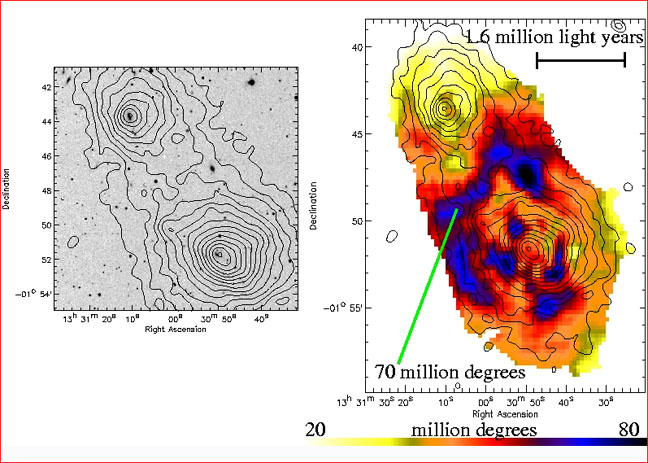
home •
about •
essential guide •
picture of the day •
thunderblogs •
news •
multimedia •
predictions •
products •
get involved •
contact
picture of the day archive subject index
Credit: XXN Newton
May 30, 2007
Cluster CollisionsWhen high temperatures showed up between two clusters, out came the only tool in the toolbox to explain it--another collision in an expanding universe.
In the Big Bang universe, where everything has been exploding apart for 13 billion years, it’s amazing how many things are bumping into each other. Astronomers have only one force to work with—gravity—which works by attraction. So whenever an energetic event is found, like the high temperature in the above galaxy clusters, it must have been caused by a gravity-driven collision.
The researcher quoted in the BBC report of this finding was puzzled. This was the first time the clusters were studied in x-ray wavelengths. Previous studies in visible light seemed to show two serene, undisturbed galaxy clusters. Yet the x-ray study shows a very hot temperature (70 million degrees) at the interface between the two clusters. Why should that be?
Astronomers consider plasma to be an ionized gas that behaves according to the same laws that a neutral gas follows, with some modification for magnetic effects. Because they cannot directly measure the properties of extragalactic space, they have developed mathematical models based on the behavior of neutral gases.
Hannes Alfvén, the father of plasma cosmology, took a different approach. In the opening to his monograph, Cosmic Plasma, he describes how the pure theory approach lost touch with reality. Rather than theorize about how plasma is supposed to act, he studied how it actually behaves in the laboratory. Among the many differences between plasma’s actual behavior and the theoretical model are temperature anomalies like the one in the galaxy clusters above: temperatures of ions and electrons are 10 to 100 times higher than expected in neutral gases. So, from an Electric Universe point of view, the anomalous temperature seen in the above galaxy clusters are a normal property of the plasma interaction between clusters.
The BBC article goes on to mention that our own Milky Way, along with our Local Cluster, is headed for a collision with the enormous Virgo Cluster a few billion years down the road. If Halton Arp’s observations are correct, this simply isn’t true. The apparent collision course is another distortion caused by astronomers’ failure to account for an age-related component to redshift. The Virgo cluster is simply older than the Milky Way: It may be the Milky Way’s parent.
Please visit our Forum
_________________________________The Electric Universe monograph and The Electric Sky book available now!
![]()
home •
thunderblogs •
forum •
picture of the day •
resources •
team •
updates •
contact us
EXECUTIVE EDITORS:
David Talbott, Wallace Thornhill
MANAGING EDITORS:
Steve Smith, Mel Acheson
CONTRIBUTING EDITORS: Michael Armstrong, Dwardu Cardona,
Ev Cochrane,
C.J. Ransom, Don Scott, Rens van der Sluijs, Ian Tresman
WEBMASTER: Brian Talbott
Copyright 2007: thunderbolts.info
